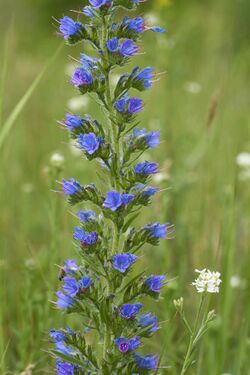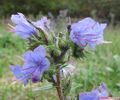Biology:Echium vulgare
| Viper's bugloss | |
|---|---|

| |
| Scientific classification | |
| Kingdom: | Plantae |
| Clade: | Tracheophytes |
| Clade: | Angiosperms |
| Clade: | Eudicots |
| Clade: | Asterids |
| Order: | Boraginales |
| Family: | Boraginaceae |
| Genus: | Echium |
| Species: | E. vulgare
|
| Binomial name | |
| Echium vulgare | |
Echium vulgare, known as viper's bugloss and blueweed,[1] is a species of flowering plant in the borage family Boraginaceae. It is native to most of Europe and western and central Asia[2][3] and it occurs as an introduced species in north-eastern North America, south-western South America and the South and North Island of New Zealand.[1][4] The plant root was used in ancient times as a treatment for snake or viper bites.[5] If eaten, the plant is toxic to horses and cattle through the accumulation of pyrrolizidine alkaloids in the liver.[6][7]
Description
It is a biennial or monocarpic perennial plant growing to 30–80 cm (12–31 in) tall, with rough, hairy, oblanceolate leaves.[8] The flowers start pink and turn vivid blue, and are 15–20 mm (0.59–0.79 in) in a branched spike, with all the stamens protruding. The pollen is blue[9] but the filaments of the stamens remain red, contrasting against the blue flowers. It flowers between May and September in the Northern Hemisphere. The Latin specific epithet vulgare means common.[5]
Distribution
It is native to Europe and temperate Asia. It has been introduced to Chile ,[10] New Zealand[11] and North America, where it is naturalised in parts of the continent including northern Michigan,[3] being listed as an invasive species in Washington (state) .[12] It is found in dry, calcareous grassland and heaths, bare and waste places, along railways and roadsides and on coastal cliffs, sand dunes and shingle.[13]
Cultivation
E. vulgare is cultivated as an ornamental plant, and numerous cultivars have been developed. The cultivar 'Blue Bedder' has gained the Royal Horticultural Society’s Award of Garden Merit.[14][15]
Gallery
See also
- Monofloral honey
- North American nectar sources
References
- ↑ 1.0 1.1 Dickinson, T.; Metsger, D.; Bull, J.; & Dickinson, R. (2004) ROM Field Guide to Wildflowers of Ontario. Toronto:Royal Ontario Museum, p. 203.
- ↑ Flora Europaea: Echium vulgare
- ↑ 3.0 3.1 {{citation | mode = cs1 | title = Echium vulgare | work = Germplasm Resources Information Network (GRIN) | url = | publisher = [[Organization:Agricultural Research ServAgricultural Research Service (ARS), United States Department of Agriculture (USDA) | access-date = 17 December 2017 }}
- ↑ "Echium vulgare L.". Plants of the World Online. Royal Botanic Garden, Kew. https://powo.science.kew.org/taxon/urn:lsid:ipni.org:names:115950-1.
- ↑ 5.0 5.1 "Echium vulgare - Plant Finder". Missouri Botanical Garden. http://www.missouribotanicalgarden.org/PlantFinder/PlantFinderDetails.aspx?taxonid=277970.
- ↑ "Guide to Poisonous Plants – College of Veterinary Medicine and Biomedical Sciences". Colorado State University. https://csuvth.colostate.edu/poisonous_plants/Plants/Details/38.
- ↑ Klemow, Kenneth M.; Clements, David R.; Threadgill, Paul F.; Cavers, Paul B. (1 January 2002). "The biology of Canadian weeds. 116. Echium vulgare L.". Canadian Journal of Plant Science 82 (1): 235–248. doi:10.4141/P01-058.
- ↑ Graves, Melissa; Mangold, Jane; Jacobs, Jim. "Biology, Ecology and Management of Blueweed". Montana State University. http://store.msuextension.org/publications/AgandNaturalResources/EB0195.pdf.
- ↑ Dorothy Hodges (1952). The pollen loads of the honeybee. Bee Research Association Ltd., London.
- ↑ "Description and images of Echium vulgare (Hierba azul , Viborera , Ortiguilla), a native Chilean plant, provided by the supplier of native exotic Chilean seeds, Chileflora.com". http://www.chileflora.com/Florachilena/FloraEnglish/HighResPages/EH0022.htm.
- ↑ "Echium vulgare" (in en). https://www.nzpcn.org.nz/flora/species/echium-vulgare/.
- ↑ "Common viper's bugloss: Echium vulgare (Lamiales: Boraginaceae): Invasive Plant Atlas of the United States". Invasive Plant Atlas of the United States. http://www.invasiveplantatlas.org/subject.html?sub=5564.
- ↑ Fitter, R. & A. (1974). The Wild Flowers of Britain and Northern Europe. Collins.
- ↑ "RHS Plantfinder - Echium vulgare 'Blue Bedder'". https://www.rhs.org.uk/Plants/139228/i-Echium-vulgare-i-Blue-Bedder/Details.
- ↑ "AGM Plants - Ornamental". Royal Horticultural Society. July 2017. p. 35. https://www.rhs.org.uk/plants/pdfs/agm-lists/agm-ornamentals.pdf.
- Blanchan, Neltje (2005). Wild Flowers Worth Knowing.. Project Gutenberg Literary Archive Foundation.
Wikidata ☰ Q157722 entry
 |






